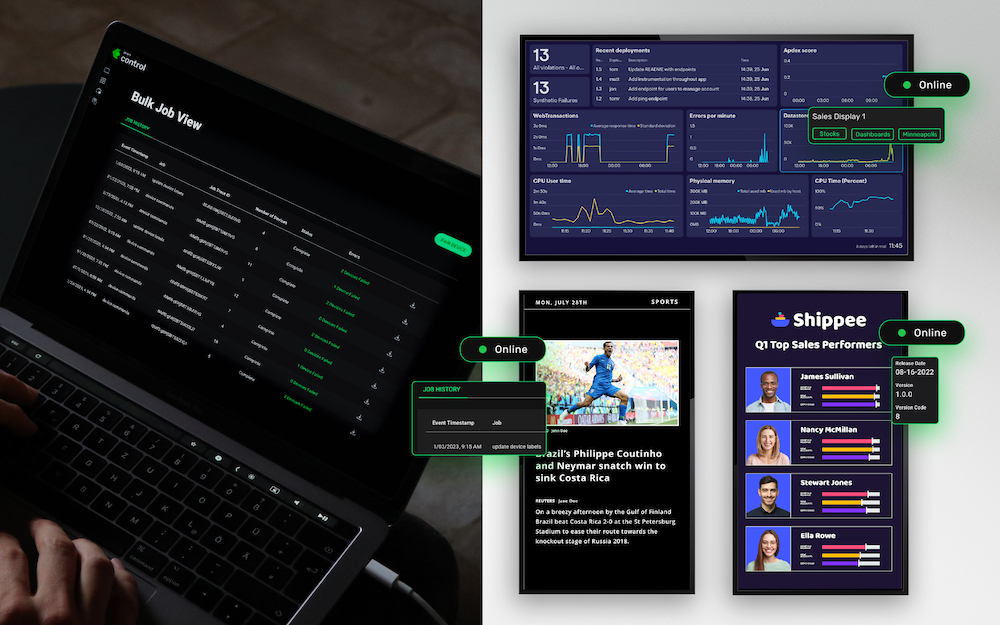Mobile Device Management (MDM) is a powerful software solution that allows organizations to remotely manage and secure various devices, such as tablets and digital signage devices.
In this discussion, we’ll concentrate on MDM’s role in digital signage.
As device management becomes increasingly vital for digital signage, it enables organizations to control and monitor their devices from a centralized location, ensuring seamless operations. MDM solutions also offer essential tools for troubleshooting and diagnosing issues, helping to reduce downtime and enhance the overall effectiveness of digital signage.
Before delving into the key benefits and use cases of MDM for digital signage, it’s crucial to gain a high-level understanding of how MDM functions.
Don’t worry if it doesn’t make sense right away – it didn’t for me either, but we’re in this together, and we’ll explore the concept step by step!
How does Mobile Device Management work?
MDM operates on a client-server model. In this framework, the server acts like a command center that sends information or instructions to the client, which could be a device such as a tablet or digital signage display. The client then receives the information or commands and executes them accordingly. If you already grasp this concept, feel free to skip this section, but for those who need a more relatable example, here’s one:
Consider MDM as a game of catch between two people – the server and the client. The server (person) throws a ball (representing information or commands) to the client, who catches it. This ball could represent a command for the device, such as sending a screenshot of the currently playing content or rebooting the device.
By employing this model, MDM solutions enable organizations to manage and secure their mobile devices remotely from a central location. This streamlined approach simplifies control and monitoring processes while reducing the need to dispatch employees or service vehicles to address issues in person.
The Importance of MDM for Digital Signage
With a foundational understanding of MDM, the big question remains: why does it matter? I’m glad you’ve come this far, and I appreciate your continued interest. So, let’s delve into the reasons. Digital signage is an effective communication tool, but managing a fleet of devices can be challenging. Without MDM, organizations face issues that can impact the efficiency and cost of their digital signage network. Here are a few examples:
- Security risks:
Unsecured digital signage devices are vulnerable to hacking, malware, and other cyber threats. MDM ensures devices receive the latest security patches and keeps data protected. - Technical issues:
Digital signage devices can experience technical problems that often require remote fixes, unlike dealing with a family member’s computer issue. From unexpected software crashes to Wi-Fi password changes, MDM offers tools to diagnose and resolve these issues quickly. - Application management:
Managing applications on numerous digital devices can be overwhelming. MDM streamlines the process by offering tools for scheduling, distributing, and updating applications across all devices simultaneously, helping to avoid downtime when devices are critical to business operations. - Cost savings:
I don’t have an MBA or anything, but this one is pretty obvious – deploying technicians to fix devices is expensive for companies. One point-of-sale provider in Canada reported an average cost of $1,200 per technician visit to troubleshoot device issues – and the most common fix is simply restarting the device.
Who would benefit from an MDM?
Everyone would benefit from an MDM – have kids? Add an MDM to their phones and track everything they do! Just kidding, but seriously, that does exist, it just isn’t the use case we are covering here. Some examples of different ways you can use an MDM in your professional life are:
POS Providers
When the device is critical to the operation of your customers’ business, point-of-sale providers need to make sure that their devices are running smoothly for their customers. You also need to make sure that the device is used for its intended purpose, not browsing the internet.
An MDM will allow you to lock the device into Kiosk mode preventing a customer or employee from using any purpose other than what was intended. When a POS goes down it isn’t something that can wait to have a technician sent out to fix. With an MDM, POS providers are able to troubleshoot a wide range of issues, from checking logs to updating the application entirely in order to get the business back up and running.
Ad Network Companies
Ad Networks can significantly improve operational efficiency using an MDM for their digital devices. MDMs allow for the streamlined deployment of new devices in the field from a central location.

The ability to manage security updates from a centralized location is incredibly powerful for ad networks since these devices are often displayed at a client location and are in high-traffic areas. If a device were to go down that means that the ads are not running for their customers, which directly impacts their bottom line, so it is critical to be able to troubleshoot issues remotely.
Banks
Within banks, the most common department that is going to be using an MDM solution is going to be the IT department. Often the IT team is inundated with tickets and requests to troubleshoot issues regarding software and hardware, and having the ability to manage devices remotely helps free up time and save money from sending someone out to fix the issue in person.
Most MDM platforms these days have an alerting option to let a group of people know that a specific device has gone offline when it should not have. This allows IT teams to proactively troubleshoot, not waiting until an employee or a customer comments on the malfunctioning screen.
Conclusion
MDM is a crucial resource for organizations seeking to manage and secure their kiosk and digital signage devices in a more efficient, scalable, and streamlined manner.
With a centralized platform for controlling and monitoring digital signage devices, MDM enables businesses to tackle security risks, technical difficulties, and content management challenges head-on. There are numerous factors to consider when selecting the right MDM solution for your business, such as compatibility, scalability, and security features.
While the decision-making process may seem daunting, this discussion aims to provide a solid foundation for your research, equipping you with the essential knowledge to make an informed choice. Remember, the right MDM solution can make a significant impact on the success of your deployment and overall business operations.
Discover the Power of Control MDM: Boost Efficiency, Security, and Performance Across Industries – Get Started Today!





